
Полная версия
Plant Solutions
Height and spread: 25cm × 30cm (10in × 12in)
Companion plants: Best co-ordinated with attractive foliage plants, particularly with silvery or grey leaves. Trailing plants such as Sutera, Dichondra argentea ‘Silver Falls’ and the very silvery Lotus berthelotii would make fine companions.
Calibrachoa ‘Million Bells’
Tender perennial
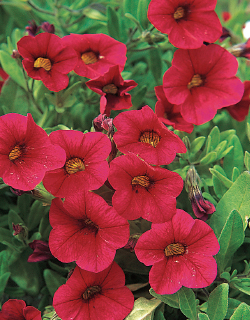
Close relative of the petunia, producing masses of long, trailing stems, richly furnished with flattened, flared, trumpet flowers up to about 3cm (1in) across. One of the best trailing plants for hanging baskets or large containers. ‘Million Bells’ series has flowers in pink, mauve, dusky yellow, white and terracotta.
Soil preference: Any well-drained
Aspect: Sun
Season of interest: Summer
Height and spread: 15cm (6in) high, trailing 1m (3ft 3in) stems
Companion plants: Teams will with such trailing foliage plants as Lotus berthelotii or Helichrysum petiolare ‘Variegatum’ but also excellent when grown alone.
Felicia amelloides
Blue Daisy, African Blue Daisy Tender perennial
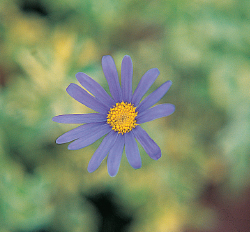
Bushy or slowly trailing perennial with rounded, deep green, slightly pubescent leaves and masses of yellow-centred, bright blue daily flowers held on thin, erect stems. The form ‘Santa Anita’ is the toughest, sometimes surviving a touch of frost, and flowers throughout summer.
Soil preference: Any free-draining
Aspect: Sun
Season of interest: Summer, early autumn
Height and spread: 40cm × 60cm (1ft 4in × 2ft)
Companion plants: Magnificent if contrasted with bright yellow or orange flowers. Tagetes, especially clear yellow varieties, blend sweetly as does Bidens ferulifolia.
Nemesia denticulata and allies
Tender perennial
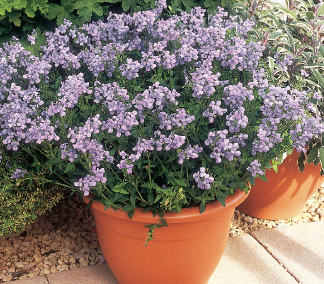
Mound-forming perennial with thin, easily snapped stems, which are quick to regenerate, and generous, long-lasting sprays of sometimes fragrant flowers shaped like small, open snapdragons. Colours range from white to pastel lilac, purple and pink tones.
Soil preference: Any, not too dry
Aspect: Sun or part shade
Season of interest: Summer
Height and spread: 30cm × 40cm (1ft × 1ft 4in)
Companion plants: Best grown on its own, especially in a large pot or hanging basket.
Bidens ferulifolia
Bidens, Beggarticks Tender perennial
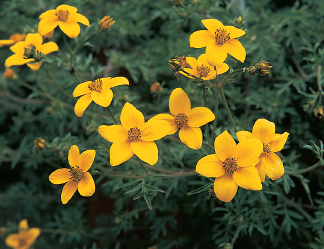
Lax perennial, whose much branched stems trail elegantly among other vegetation. The deeply divided foliage makes a pretty foil for the big, golden, honey-scented blooms which are produced constantly through summer. A classic and drought-tolerant basket plant, but also fine in a border, where it can sprawl among other perennials.
Soil preference: Any
Aspect: Sun
Season of interest: Summer
Height and spread: Up to 45cm (1ft 6in) trailing
Companion plants: Lovely with silver foliage of trailing Helichrysum or trailing Plectranthus. Superb when making a startling contrast with the vigorous Verbena ‘Homestead Purple’.
Sutera (syn. Bacopa)
Tender annuals or perennials
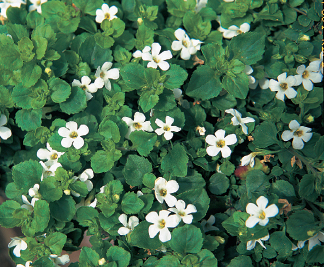
South African plants with bushy but trailing or sprawling habit and slightly toothed triangular or rounded leaves. The flowers are tiny – forget-me-not sized – but are produced in profusion through much of summer. Pastel shaded cultivars include ‘Blue Showers’, ‘Lilac Showers’ and ‘Pink Domino’. White forms include ‘Snowstorm’, ‘Snowflake’ and Sutera cordata ‘Blizzard’.
Soil preference: Any
Aspect: Sun
Season of interest: Summer
Height and spread: 10cm × 45cm (4in × 1ft 6in)
Companion plants: Suteras have become standard basket and window box plants and will mix with practically anything. They are ideal for softening edges and disguising pot sides, making excellent companions for erect varieties of pelargonium and fuchsias.
Other good bedding plants
Lathyrus odoratus Dwarf varieties
Sweet Pea Hardy annual
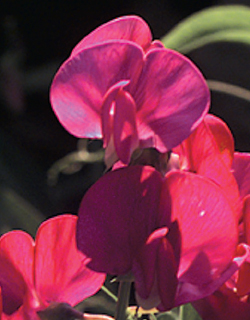
Most have the attributes of climbing sweet peas – fragrance, colourful blossoms, good cutting value – but dwarf plants need minimal support. Varieties include ‘Snoopea’, which lacks tendrils and has a prostrate but bushy habit, ‘Bijou Mixed’ and the dwarf ‘Cupid Mixed’. Colours run through pink, purples and white. Excellent for containers.
Soil preference: Any fertile, free-draining but moisture-retentive
Aspect: Sun
Season of interest: Summer
Height and spread: Variable to 30cm (1ft)
Companion plants: Effective in small bedding schemes alongside leafy plants such as Senecio cineraria or as part of a mixed container, with Nemesia or Torenia.
Heliotropium arborescens
Heliotrope, Cherry Pie Tender shrub, grown as bedding
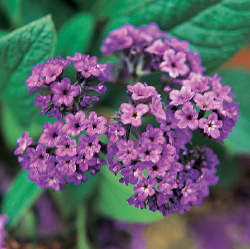
A rounded shrub, in the forget-me-not family with handsome oval and deeply veined leaves that are often purple-tinged. Large heads of tiny, rich purple flowers which smell sweetly of vanilla. When used in bedding, heliotropes can be trained as standards or pruned and pinched back to sustain bushiness. Fine varieties include ‘Princess Marina’, whose flowers are deep purple-blue, ‘Chatsworth’, slightly paler purple and also very fragrant, and ‘White Lady’.
Soil preference: Any
Aspect: Sun
Season of interest: Summer
Height and spread: To 90cm × 60cm (3ft × 2ft)
Companion plants: The classic ‘dot’ plant of Victorian bedding, useful for giving height to beds of impatiens, petunias or to contrast strongly with French marigolds.
Nicotiana mutabilis ‘Marshmallow’
Tobacco Plant Tender perennial
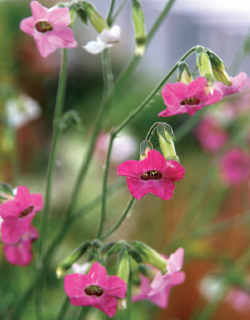
This plant has large, floppy leaves which are sticky to the touch above which grows a mass of branched, slender stems bearing trumpet-shaped flowers which open white and gradually flush to a pale and then a deep cherry pink. Each flower has a dark eye and in the evening, exudes a delicious fragrance.
Soil preference: Any, fertile and free-draining
Aspect: Sun
Season of interest: Summer
Height and spread: 1.2m × 75cm (4ft × 2ft 6in)
Companion plants: Big, bold bedding plants, ideal to soften the harshness of large dahlias or to intersperse among Verbena bonariensis for a light, airy effect.
Viola x wittrockiana
Small-flowered Violas Hardy perennial or biennial
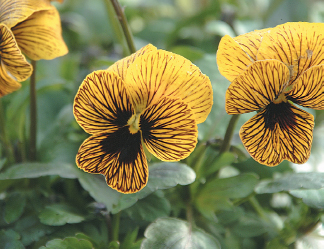
Neat, mat-forming perennials or biennials with slightly lobed, heart-shaped leaves and stems which are square in section. A constant run of small, pansy flowers is produced in a vast range of colours and patterns, ranging through blues, mauves, yellow, orange, purples and to almost black or tan red. Many have bi-coloured blooms or monkey faces; all have a sweet-sharp, honey fragrance.
Soil preference: Any reasonably fertile, not too dry
Aspect: Sun or part shade
Season of interest: Year round
Height and spread: Variable to 20cm × 30cm (8in × 1ft)
Companion plants: Adaptable to any situation – in containers, beds, rock gardens or even lining vegetables in a kitchen garden. Especially effective with spring bulbs or over-wintered plants such as polyanthus, primroses or wall flowers.
Verbena ‘Blue Lagoon’
Verbena Tender perennial
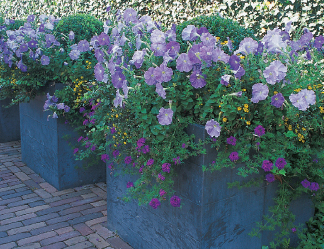
Oval, toothed leaves and semi-trailing stems which produce a summer-long succession of umbels bearing true blue flowers. Said to be resistant to mildew – a bugbear disease for bedding verbena – and to have sweet fragrance. A seed-raised series, but can be propagated from cuttings or divisions.
Soil preference: Fertile and free-draining
Aspect: Sun
Season of interest: Summer, autumn
Height and spread: 25cm × 30cm (10in × 12in)
Companion plants: An excellent container plant to trail with such gold-leaf companions as Lamium ‘Golden Anniversary’ or with Lysimachia nummularia ‘Aurea’.
Zaluzianskya capensis
Night Phlox Tender annual
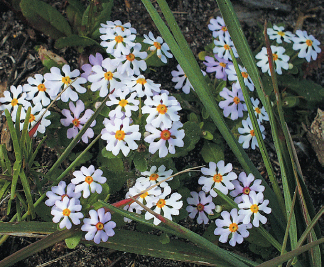
A member of the foxglove family which looks more like a pink or a campion! Sticky foliage on bushy plants is joined, in summer, by starry flowers with twin-lobed petals, which are crimson on the reverse, but white on their upper surfaces. The flowers open more fully at night when they become sweetly fragrant.
Soil preference: Any free-draining
Aspect: Sun
Season of interest: Summer
Height and spread: To 60cm × 45cm (2ft × 1ft 6in)
Companion plants: Try fusion planting, growing these South African beauties along with the equally sweetly scented and nocturnal Marvel of Peru or Mirabilis jalapa, and with tobaccos.
Begonia semperflorens
Tender perennial
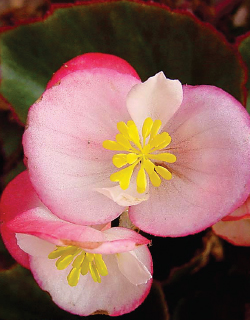
Universally popular bedding plant with thick, fibrous roots, succulent stems and glossy, fleshy leaves which are rounded and may be bright green, or bronze or purple tinted. A constant run of flowers in colours ranging from scarlet, through reds and pinks to white. Good seed series are legion, for example, ‘Doublonia’ series and ‘Stara Mixed’.
Soil preference: Any
Aspect: Sun or part shade
Season of interest: Summer
Height and spread: To 30cm × 30cm (1ft × 1ft)
Companion plants: Best for bedding schemes, on account of their ability to make long-lasting carpets of colour. Also effective as texturing plants with grasses, perhaps, or for use in mixed containers with Helichrysum petiolare, Brachyscome or Senecio ‘Silver Dust’.
Brassica oleracea
Ornamental Cabbage, Ornamental Kale Hardy biennial
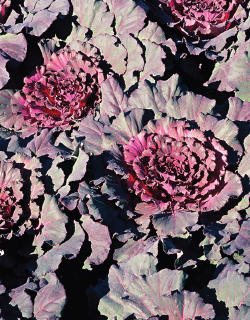
Valuable for their winter displays, ornamental cabbages and kales provide strong colours from their colourful foliage. The cabbages form loose but symmetrical rosettes with purple, rose-mauve, pink or creamy suffusions mixed with green. The kales have a more open, lax habit. The flowers, which follow in late spring, are yellow and usually clash with the coloured leaves.
Soil preference: Any
Aspect: Sun
Season of interest: Autumn, winter, spring
Height and spread: To 45cm × 30cm (1ft 6in × 1ft)
Companion plants: Useful for a strong colour display for winter but difficult to team with smaller flowers. Certain tulips, particularly in white, purple or pink shades, go surprisingly well.
Salpiglossis sinuata
Tender annual
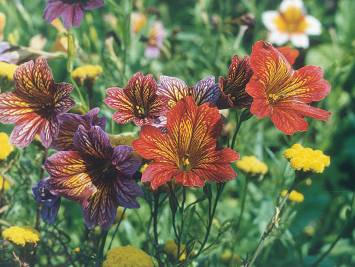
A South American member of the potato family with slender habit, sparsely branched stems and slightly sticky foliage. During much of the summer, these plants produce a long succession of trumpet-shaped flowers. These are deeply veined and come in attractive, dusky colours ranging through yellows, brick red and orange to violet and purple-blue.
Soil preference: Any free-draining
Aspect: Sun
Season of interest: Summer
Height and spread: 60cm × 30cm (2ft × 1ft)
Companion plants: Striking, characterful plants which need backing up with other, foliage-rich companions such as heliotropes, Centaurea cineraria or scented leaf pelargoniums.
Canna indica, C. iridiflora
Tender perennials
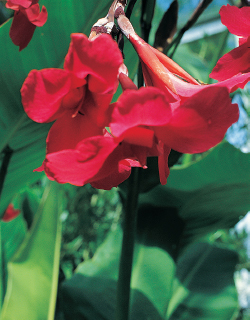
Large, coarse perennials with broad, oar-shaped, glossy surfaced leaves which unfurl like rolled banners; in some varieties these are dark-tinted or striated. The flowers, which resemble untidy irises, are produced in bunched panicles and come in shades of pink red, yellow, orange or white. The species C. iridiflora (pictured) grows taller and has gracefully hanging pink flowers.
Soil preference: Moist, fertile
Aspect: Sun
Season of interest: Summer
Height and spread: To 2.5m × 1m (8ft × 3ft)
Companion plants: Traditionally used as dot plants, in bedding schemes and effective when presiding over drifts of French marigolds, pelargoniums, Impatiens or nicotianas. Also fine in containers with Mexican salvias and Solanum rantonetii.
Cosmos bipinnatus, C. sulphureus
Hardy or near hardy annuals
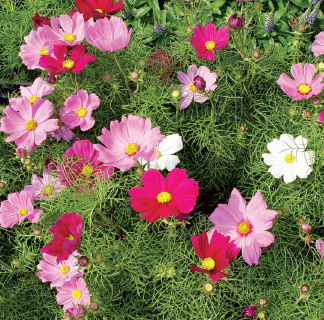
Two variable species, with divided, often lacy foliage and an open, branching habit. The flowers are composite with yellow central florets and broad, showy outer ray florets which may be flat or, in some varieties such as ‘Seashells’, tubular. Flowers of C. bipinnatus range from deep rose or crimson through pinks to white. C. sulphureus comes in hotter colours ranging from yellow to coppery orange or near red.
Soil preference: Fertile but free-draining
Aspect: Sun
Season of interest: Summer
Height and spread: Variable to 2m × 45cm (6ft × 1ft 6in)
Companion plants: Fast-growing plants whose soft, lacy foliage provides a gentle tracery, striking when accompanied by bedding such as annual Lavetera, petunias or dense masses of fuchsias. Also pretty dotted in a flower border, perhaps with cleomes.
Dahlia
Half hardy perennials
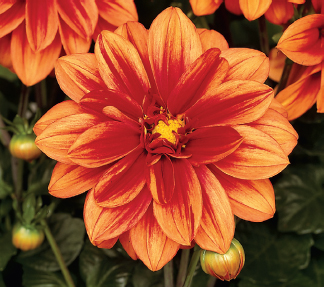
A variable genus with huge plants, bearing vast blooms the size of a hat down to more modest, dwarf varieties. Many-branched stems rise from fleshy tubers in late spring and are furnished with divided, glossy, sometimes dark foliage. The late summer flowers are variable, usually brightly coloured with every hue except pure blue. Seed series such as ‘Duo’ or the dark-leaved ‘Bishop’s Children’ are good for bedding.
Soil preference: Any fertile, free-draining but not too dry
Aspect: Sun
Season of interest: Summer, autumn
Height and spread: Variable to 2m × 75cm (6ft × 2ft 6in)
Companion plants: Medium and small flowered varieties, especially those with dark foliage, are popular, blending with lilies among shrubs or in a late summer border with heleniums, late daisies or chrysanthemums.
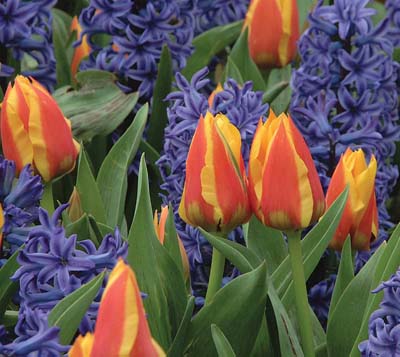
Bedding Schemes Used Formally and Informally
Bedding schemes can be tailored to suit a diverse range of tastes and preferences. Plants, in formal bedding, are used en masse to create a colourful surface and their use can appear to be more akin to painting than to planting! Bold brush-strokes of colour, sometimes creating formal patterns or shapes, often in the commemoration of an event, are popular in public planting schemes and are intended to provide sudden drama and spectacle, rather than to sustain a gentle, changing scene.
However, bedding can also be used in an informal way, simply arranging for drifts of similar plants to make small statements, perhaps as part of a border, or for giving temporary lift to an otherwise dull spot.
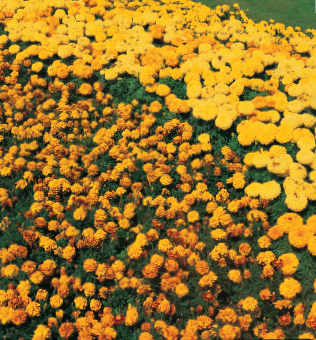
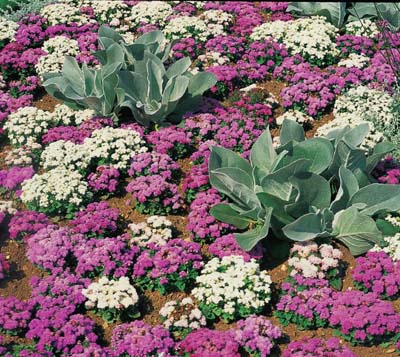
Vibrant colours
The main picture opposite shows a harmonious spring bedding display using botanical tulips, Tulipa kaufmanniana ‘Stresa’, with Hyacinthus orientalis ‘Blue Jacket’. The three strong colours, red, yellow and blue, work superbly together and bring bright spring cheer. The display will not be long-lived, however, and will leave a sizeable gap by the end of spring.
Painting with flowers
In this scheme (see the bottom picture on the opposite page), bold swirls of Tagetes (French and African marigolds) create a dazzling surface which is so intense in colour that it can almost cause physical discomfort to view, particularly in low light conditions. However, where the sun is strong, hard colours like these can be surprisingly effective. The effect is one of drama, rather than to entice long, lingering looks!
Using dot plants to lift the scheme
Common bedding plants such as these Ageratum (above) can be augmented with less usual choices to add interest to an otherwise rather pedestrian planting scheme. The Verbascums are used here for the silver foliage but later they will produce handsome flower spikes and make strong accent plants.
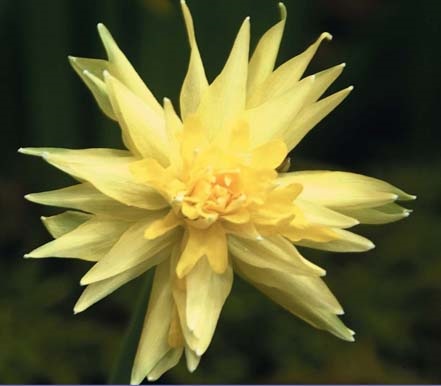
bulbs
Bulbs: medium and tall for spring
Dwarf bulbs for winter and spring
Focus on… Narcissus
Bulbs: medium and tall for summer
Bulbs: medium and tall for spring
Fritillaria imperialis
Crown Imperial Hardy bulb
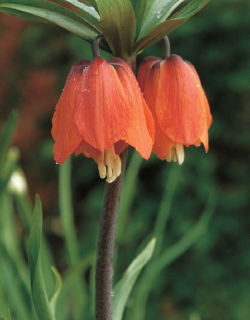
Largest of the fritillaries and ancient in cultivation. Big, pungent-smelling bulbs producing thick, fleshy stems, furnished with glossy, narrow leaves along their length. At their tips, clusters of large, dark-veined, orange or yellow bell-shaped flowers form below a topknot of foliage. The petal bases have glands which drip tears of nectar.
Soil preference: Any, well-drained
Aspect: Sun or part shade
Season of interest: Spring
Height and spread: 1m × 45cm (3ft 3in × 1ft 6in)
Companion plants: Big, bold spring plants for dotting among developing summer perennials or to naturalize among such ornamental trees as cherries, crab apples or hawthorns.
Fritillaria pallidiflora
Hardy bulb
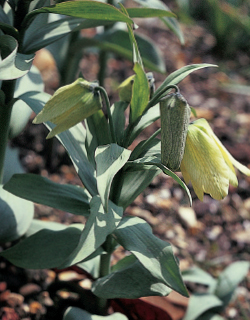
A variable species with paired, narrow, grey-green leaves and thin stems which bear groups of two, three or four cup-shaped nodding flowers in a pale beige to creamy primrose. The bulbs are slow to increase and so work better in small groups than singly.
Soil preference: Any free-draining, but not too dry
Aspect: Sun or part shade
Season of interest: Spring
Height and spread: To 45cm × 10cm (1ft 6in × 4in)
Companion plants: Superb when grown with other fritillaries and late spring flowers. Species tulips such as Tulipa sprengeri and T. acuminata go well, as does Fritillaria verticillata.
Hyacinthoides non-scripta
English Bluebell Hardy bulb
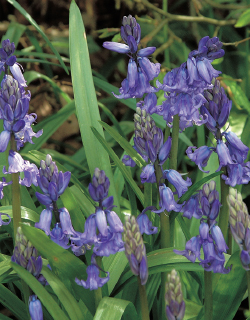
Dark, glossy, narrow foliage begins to emerge in early spring. The flower stems extend in mid spring, and carry clusters of hanging, bell-shaped, fragrant, dark blue flowers. Albino and pink forms also occur but are rare. Successful growth depends on a relationship the plants have with micro-organisms in the soil, and establishment can be difficult. Plant ‘in the green’ (ie. in leaf).
Soil preference: Woodland soil, high in organic matter
Aspect: Shade or part shade
Season of interest: Spring
Height and spread: To 45cm × 10cm (1ft 6in × 4in)
Companion plants: Suitable for naturalizing in shady places and beautiful with wood anemones, ragged robin, primulas or red campion.
Erythronium ‘Pagoda’
Dog’s Tooth Violet Hardy bulb
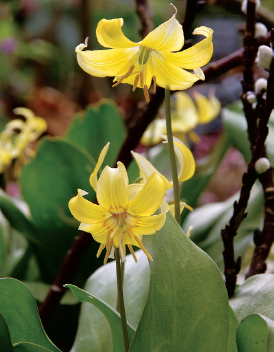
A garden hybrid with broad, richly decorated, glossy foliage, which creates a fine base for the sprays of elegant flowers. These are up to 5cm (2in) across, with pale yellow petals which curl to create a pagoda effect.



